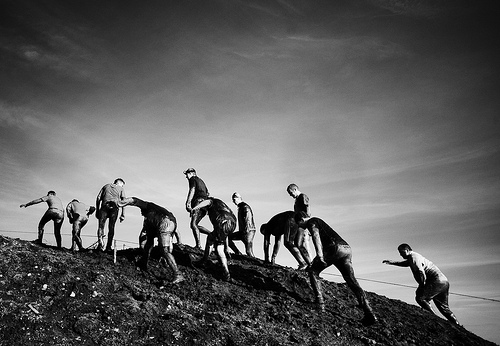
See the big picture.
Galileo discovered, in the course of innovating the first telescope, that each lens he added enabled him to have a more comprehensive, accurate perspective of the sky. Today’s telescopes have lenses that enable scientists to see more and more accurately the celestial bodies in evening skies, enabling discovery never before possible.
Framing is a tool, like the telescope, that enables us to have and act from a broadened, more accurate perspective of people. Lee G. Bolman and Terrence E. Deal, in their book, “Reframing Organizations, Artistry, Choice and Leadership” provide a useful guide to framing for leaders, one that we can apply for heightened effectiveness and impact at work. I believe this ability, which I liken to zooming, provides a significant advantage to leaders in building credibility, making good decisions, and leading people through change.
As leaders, we often have approaches that lean either toward being rational/technical, with an emphasis on control and predictability, or leaning more toward being interpretive/flexible, emphasizing creativity and innovation. Read on, and see what you think about Framing as a leadership tool and approach.
The 4 Frames
I can think of many times I’ve seen a leader’s actions interpreted very differently by different people — going back to the 6 Blind Men story, we can easily see how that can happen. For example, a decision to hire from outside for a position can be viewed as evidence the leader doesn’t value current employees or care about their growth; or, it may be viewed as logical, to add a new position in a function based on work requirements; it could also be viewed as a move to obtain a scarce resource and increase a power base; it could be viewed as evidence of valuing a team through the investment of additional talent. Each of the 4 frames has its own view of reality. We all operate from these frames, usually with one dominant frame coloring our mindset or perspective of organizational life. Only when we understand and consider all 4 frames can leaders fully appreciate the way our people take in and internalize organizational events, and leadership communications, decisions and actions. Framing enables us to better connect with people and to be more accurately understood.
The Structural Frame
Do you see Planning as a process to set objectives and to allocate resources? Do you prioritize activities such as documenting organizational structure, job descriptions, policies, procedures and reporting relationships? Do you view the “technical” quality of a decision as of primary importance? Is your purpose in communicating to transmit facts and information? Do you see the purpose of reorganization as realigning roles and responsibilities to fit tasks and the business environment? Do you see meetings as formal decision-making activities? Do you see money as the primary motivator for people? These are a few examples of a mindset aligned with the structural frame. Here, logical, rational, fact-based decisions, communications and actions are emphasized. Employees operating from this as their dominant frame expect leaders to act with these as priorities. They interpret leadership actions in relation to this standpoint.
The Human Resource Frame
I wish Bolman and Deal had named this the “Human” frame, to avoid its being interpreted as relating the Human Resources people or the HR Function. While this frame may fit some HR people or functions, it certainly isn’t a universal mindset for that group or any other organizational entity. None of these Frames is meant to correspond to any organizational group or function. Check this frame out by thinking about the following questions.
Do you see Planning processes as gatherings to promote participation? Do you see it as critically important to anticipate the impact of decisions and actions on employees, and to find ways of reducing or avoiding negative impact? Do you view people’s feelings, needs and development as being critically or very highly important? Is communication a vehicle to share information, needs and feelings? Is your purpose in reorganization to realign people’s roles to better fit their interests, passions and needs? Do you see meetings as informal gatherings to involve people in sharing input, feelings and opinions for decision making? Do you believe people are motivated by growth and self-actualization? These are examples of the mindset in the Human Resource Frame. Here, people’s feelings and needs are emphasized. Employees operating from this as their dominant frame expect leaders to act with these as priorities, and interpret leadership actions from this standpoint.
The Political Frame
Organizational politics can be both a positive and/or a negative force in any organization, depending on how it is played out by people and how it impacts organizational culture. Looking at the political frame objectively is important to understanding this mindset or perspective accurately. This frame is focused on the requirement of leaders to have resources, power, and influence to drive success in the organization, where resources are limited if not scarce. Do you view the Planning process as a platform to air conflicts and issues? Do you prioritize negotiating, networking, and building alliances? Do you view decision making as opportunity to leverage power? Is communication a tool to influence people? Is reorganization a process to redistribute power and form new strategic relationships? Do you see meetings as competitive opportunities with winners and losers? Do you see leaders as best able to motivate people using manipulation and persuasion? These are a few examples of the Political Frame. Employees operating from this as their dominant frame expect leaders to act with these as priorities and they interpret leadership actions in relation to this standpoint.
The Symbolic Frame
Do you see Planning as a ritual or tradition that produces meaning and purpose? Do you see the decision making process as a ritual to keep people informed, comfortable and supported as decisions are made? Do you communicate using stories and organizational history? Do organization communications provide opportunities for story telling? Are meetings precious opportunities to celebrate and to reinforce and shape the culture? Is the purpose of reorganization to build and sustain an image of responsiveness and accountability? Is reorganization done to change the social order? Do you see people as being motivated by symbolic events and activities and celebrations? Employees operating from this as their dominant frame emphasize the building of meaning and purpose and values through establishment of traditions, symbolic activities and celebration. They expect leaders to act with these as priorities, and interpret leadership actions from this standpoint.
As I think about people I have known throughout organizations where I’ve worked, and can see their dominant frames as I reflect on things they’ve told me, their reactions to leadership actions, communications and decisions, and other conversations in which we’ve shared personal wishes and opinions. Can you identify people’s primary frames? Make a list of a few people at work, and think about it. Where are they coming from — which frame?
The Art of Framing
Again, we all have roots in all four frames, but usually one frame is our dominant or prevailing frame. As a leader, each of us can plan our own approach to meet people at their dominant frames, by strengthening our knowledge of each frame and how to connect with all four in our actions, decisions and communications. Leaders can use framing continuously, and they can also apply it situationally. There may be times when using particular frames is key for successful results. For example, when setting goals during uncertain times, the structural and symbolic frames, used together, can drive buy in and performance. Do you see how? For details on analyzing situations to leverage framing most effectively, I recommend reading the book.
Using Framing effectively can have great benefits -- credibility with your people, being accurately understood in your actions and decisions, getting buy-in and motivating people. Not using framing can have unintended consequences. What might be the implications for an organization whose leaders do not effectively apply framing as they make decisions, take actions and communicate with their people?
Like any other skill, with practice it becomes quicker and easier and, eventually, automatic to apply framing. At first, though, it does take work and some extra time. Only you can decide whether or not it’s worth the effort.
What are your thoughts? Please share your experience, opinions and ideas about Framing.
Latest posts by Rosanna Nadeau, PCLEC (see all)
- Is Quality Being Lost In Today’s Quest For Efficient Execution? - August 31, 2023
- What is HR’s Strategic Role? - August 24, 2023
- Agility: The Ability to Zig and Zag - August 23, 2023












